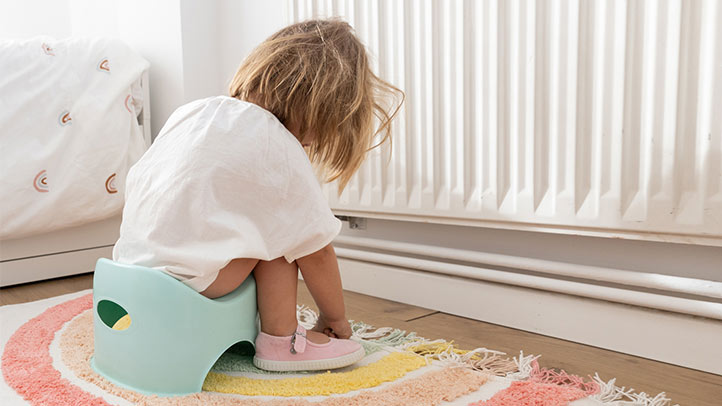Potty Training Girls vs. Boys: Understanding the Differences
Potty training is a significant milestone for both toddlers and parents. It’s a journey of independence, accomplishment, and yes, sometimes a few messes along the way. While the overall goal remains the same, there can be some subtle differences in potty training girls and boys. Here, we’ll explore these differences, address common myths, and offer tips to navigate potty training success for both genders.
 Developmental Differences
Developmental Differences
It’s important to acknowledge that physical development plays a role in potty training readiness. Here’s a look at some key differences:
1. Bladder and Bowel Control:
- Maturation Rates: While girls tend to develop bladder control earlier on average, the gap is not significant and can vary widely between individual children. This means there can be girls who are later bloomers and boys who show early signs of readiness.
- Underlying Reasons: The reasons behind the slight difference in average maturation rates are complex and not fully understood. It might be a combination of factors like hormonal differences, the nervous system’s development, and even environmental influences.
2. Muscle Development:
- Pelvic Floor Muscles: Boys generally take longer to develop the strength and coordination needed in their pelvic floor muscles for complete bladder and bowel control. These muscles are crucial for stopping and starting the flow of urine and stool.
- Impact on Potty Training: This difference in muscle development can manifest as boys experiencing more frequent accidents, especially during the initial stages of potty training. It might also take them longer to master complete control over both urination and defecation.
Here are some additional points to consider:
- Individual Variations: It’s important to remember that these are general trends, and there will be significant variations among individual children. Don’t assume that girls will automatically be easier to potty train based solely on their gender.
- Focus on Signs, not Gender: Instead of focusing on gender stereotypes, observe your child’s individual development and readiness signs. Look for physical cues like staying dry for longer stretches or showing discomfort with a full diaper, and behavioral signs like expressing interest in the toilet or following simple instructions.
- Seek Professional Guidance: If you have concerns about your child’s development or progress with potty training, consult your pediatrician. They can assess your child’s individual situation and offer personalized advice.
By understanding these developmental differences and focusing on your child’s individual readiness signs, you can create a more personalized and effective potty training approach, regardless of their gender.
Myth Busting: Common Misconceptions
Several misconceptions surround potty training girls and boys. Here’s a breakdown of some common myths:
Myth #1: Girls are Always Easier to Potty Train:
- Busted: While girls might develop bladder control slightly earlier on average, this doesn’t translate to a universally smoother potty training experience. Both girls and boys can experience setbacks, accidents, and challenges along the way.
- Reality: Every child develops at their own pace, and individual readiness plays a much bigger role in success than gender. Look for signs of physical and behavioral development in your child, regardless of their gender, to determine their readiness for potty training.
Myth #2: Boys Should Start Potty Training Later:
- Busted: There’s no set timeline for potty training based solely on gender. The most crucial factor is your child’s individual readiness, which can vary significantly between boys and girls.
- Reality: Waiting for your child to show signs of physical and behavioral readiness, regardless of their gender, is key to a successful potty training experience. Avoid comparing your child’s progress to others based on gender stereotypes.
Myth #3: Potty Training Methods Differ for Boys and Girls:
- Busted: The core principles of effective potty training remain the same for both genders: positive reinforcement, patience, and consistency are essential ingredients for success.
- Reality: While you might need to adapt your approach to your child’s individual personality and learning style, the fundamental principles of potty training remain consistent. Celebrate successes, offer encouragement, and be patient with both girls and boys throughout the journey.
Myth #4: Boys Can’t Use Potty Chairs:
- Busted: Potty chairs can be a valuable tool for both boys and girls during potty training. They offer a sense of security and familiarity, especially for younger toddlers.
- Reality: While some boys might show initial interest in standing to urinate, potty chairs can still be a helpful stepping stone in their potty training journey. You can also introduce a standing target later on, if your son shows interest.
Myth #5: Accidents Mean Your Child Isn’t Ready:
- Busted: Accidents are inevitable during potty training, and they don’t necessarily indicate a lack of readiness. They are simply a part of the learning process.
- Reality: Instead of getting discouraged by accidents, use them as a teaching opportunity. Remind your child gently about using the potty and offer positive reinforcement for trying.
Strategies for Success: Tailoring Your Approach
While the core principles remain the same, some subtle adjustments in your approach might benefit both girls and boys during potty training:
-
For Girls:
-
Focus on Wiping: Girls might need more guidance on proper wiping techniques to avoid discomfort and potential urinary tract infections. Consider using visual aids or demonstrations to ensure they understand the front-to-back wiping motion.
-
Address Leakage: Accidents due to leakage can be discouraging. Ensure proper positioning on the potty and consider practicing with underwear liners to catch small leaks before they become bigger messes.
-
-
For Boys:
-
Standing vs. Sitting: Boys might initially show interest in standing to urinate, mimicking what they see their fathers doing. While sitting is generally recommended for better control, consider offering a small target sticker in the toilet bowl to encourage aiming practice in a standing position.
-
Practice Makes Perfect: Boys might take longer to master complete bladder control. Offer frequent potty breaks and celebrate even small successes to keep them motivated. Consider using a timer to remind them to try using the potty throughout the day.
-
Remember: These are just suggestions, and the best approach might vary depending on your child’s individual needs and preferences. Be flexible and adapt your strategies as needed.
Beyond Gender: Additional Considerations
While there are some developmental differences to consider, successful potty training goes beyond just gender. Here are some additional factors to keep in mind:
- Individual Readiness: Every child develops at their own pace. Focus on your child’s unique signs of readiness, both physically and behaviorally, rather than comparing them to others based on gender.
- Communication and Openness: Talk openly and honestly with your child about potty training. Answer their questions honestly and address any anxieties they might have.
- Positive Reinforcement: Celebrate successes, no matter how small, with praise, stickers, or a simple reward chart. This positive reinforcement motivates your child and encourages them to continue trying.
- Consistency is Key: Maintain a consistent routine for potty breaks, mealtimes, and nap times. This helps your child’s body adjust and anticipate potty time.
- Patience and Understanding: Accidents are inevitable during potty training. Avoid getting frustrated or using harsh words





